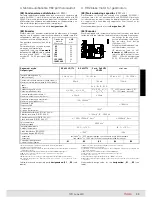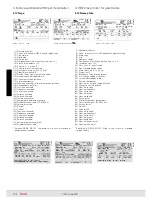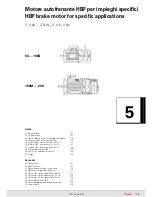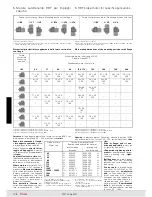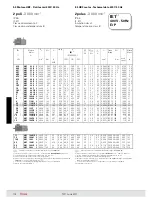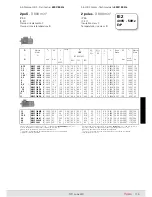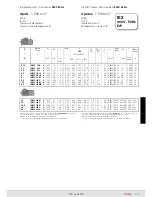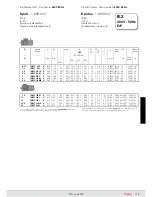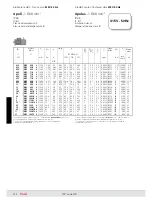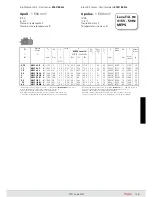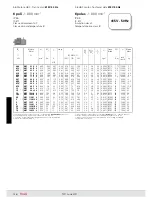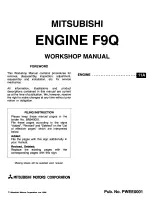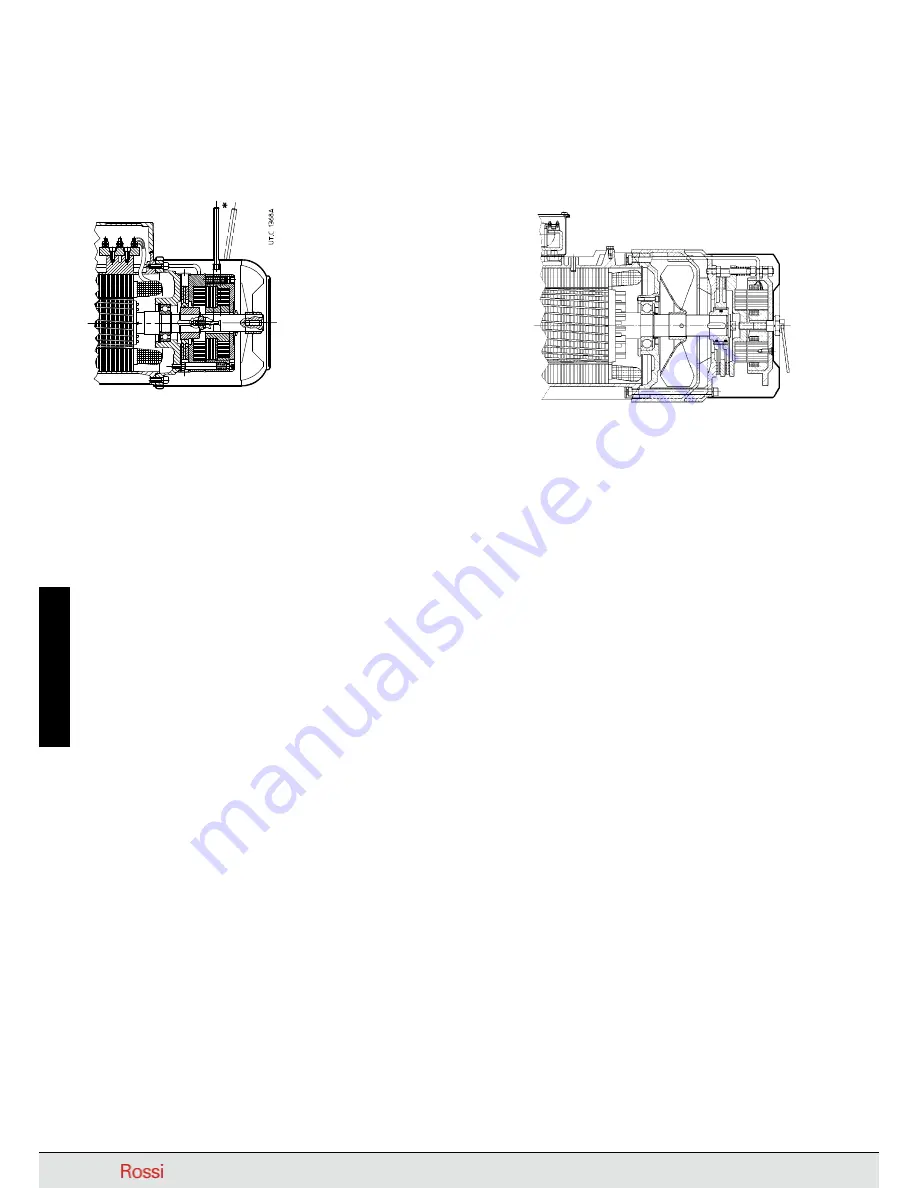
112
TX11 June 2011
5.4 Caratteristiche freno motore HBF
5.4 HBF motor brake specifications
Freno elettromagnetico a molle (si ha automaticamente frenatura
quando non è alimentato) funzionante a
corrente alternata
, a dop-
pia superficie frenante e
momento frenante elevato
(normalmente
M
f
2
M
N
) e
registrabile a gradini
(
160S)
o con continuità
(
160M).
Concepito per la
massima prontezza e precisione
di sblocco e fre-
natura (caratteristici del freno a c.a.) e
massima frequenza di fre-
natura, elevata capacità di lavoro di frenatura, elevato numero
di frenature
fra due registrazioni del traferro (più del doppio rispetto
agli altri motori autofrenanti), massima frequenza di avviamento per
il motore (lo sblocco del freno è talmente rapido da consentire un
avviamento completamente libero anche con elevate frequenze di
avviamento).
Risulta particolarmente idoneo a impieghi nei quali sono richieste
fre-
nature potenti e rapidissime
nonché elevato numero di interventi
(es.: sollevamenti con elevata frequenza di intervento, che normal-
mente si verifica per grand.
132, e/o con marcia a impulsi).
Viceversa, le sue
elevatissime caratteristiche dinamiche
(massi-
ma capacità frenante, rapidità e frequenza di intervento) generalmen-
te
ne sconsigliano l'uso
in accoppiamento
con il motoriduttore
soprattutto quando queste prerogative non siano strettamente ne-
cessarie per l'applicazione (onde evitare di generare inutili sovraccari-
chi sulla trasmissione nel suo complesso).
Ampia disponibilità di esecuzioni speciali (63…160S): encoder, ser-
voventilatore,servoventilatore ed encoder, seconda estremità d’albe-
ro, ecc.. Quando l’elettromagnete non è alimentato, l’àncora freno,
spinta dal le molle, preme il disco freno sullo scudo posteriore ge-
nerando il momento frenante sul disco freno stesso e conseguente-
mente sull’albero motore sul quale è calettato; alimentando il freno
l’elettromagnete attrae verso di sé l’àncora freno, liberando il disco
freno e l’albero motore.
Caratteristiche principali:
– tensione di alimentazione alternata trifase (nel collegamento, l’elet-
tromagnete a c.a. è simile a un motore asincrono trifase)
coordi-
nata
con quella del
motore
(ved. 5.9 (1)).;
–
morsettiera freno
per alimentazione del freno
direttamente da
morsettiera
motore o indifferentemente da linea
separata
;
– momento frenante
registrabile a gradini
cambiando il numero
degli spessori inseriti sotto le molle (
160S) o
registrabile con
continuità
mediante appositi dadi (
160M);
–
classe isolamento F, sovratemperatura classe B
;
– avvolgimenti e nucleo dell’elettromagnete
annegati in resina
iso-
lante per assicurare la durata e la resistenza agli urti, alle vibrazioni
e alle sollecitazioni termiche derivanti da servizi gravosi del freno e
per avere un funzionamento più silenzioso.
–
àncora freno di ghisa
(
160S)
, con nucleo magnetico lamellare
(
160M)
per una maggiore rapidità e minori perdite elettriche;
– disco freno (doppio per FA G9 e FA 10) scorrevole sul mozzo tra-
scinatore scanalato di acciaio, con anima sempre di acciaio per la
massima affidabilità del calettamento e doppia guarnizione d’attrito
a medio coefficiente d’attrito per bassa usura;
–
guaina antipolvere ed antiacqua
e
V-ring
(
160S) sia per im-
pedire l’entrata di inquinamento dall’esterno verso il freno sia per
evitare che la polvere di usura della guarnizione di attrito venga
dispersa nell’ambiente;
Electromagnetic spring loaded brake (braking occurs automatically
when it is not supplied), running at
alternate current
, with double
braking surface and
high braking torque
(usually
M
f
2
M
N
) and
step
adjustable
(
160S)
or adjustable with continuity
(
160M).
Conceived for
maximum quickness and precision
in releasing and
braking (typical of a.c. brake) and
maximum frequency of braking
,
high braking capacity
,
high number of brakings
between two
airgap adjustments (more than the double compared to the other
brake motors), maximum frequency of starting for the motor (rapidity
in brake releasing allows a completely free start also at high frequen-
cies of starting).
This brake motor is particularly suitable for heavy duties requiring
powerful and very quick brakings
and a high number of operations
(e.g.: hoists with high frequency of starting, normally for sizes
132,
and/or with jog operations).
Vice versa, its very
high dynamic characteristics
(maximum bra-
king capacity, rapidity and frequency of starting)
are not advisable
for the use
in
gearmotor
coupling, especially when these features
are not strictly necessary for the application (avoiding useless overlo-
ads on the whole transmission).
Comprehensive range of non-standard designs (63 ... 160S): enco-
der, independent cooling fan, independent cooling fan and encoder,
second shaft end, etc..
When electromagnet is not supplied, the brake anchor pushed by
springs, presses the brake disk on rear endshield generating the
braking torque on the same brake disk and consequentely on mo-
tor shaft it is keyed onto; by supplying the brake the electromagnet
draws the brake anchor and releases brake disk and driving shaft.
Main specifications:
– three-phase alternate supply voltage (in the connection the a.c.
electromagnet is similar to an asynchronous three-phase motor)
mathing the motor supply (see 5.9 (1));
–
brake terminal block
for brake supply
di rectly from terminal
block
of motor or indifferently from
separate
line;
–
braking torque step adjustable
changing the number of spacers
under the springs (
160S),
or
adjustable with continuity
through
the proper nuts (
160M);
–
insulation class F
,
temperature rise class B
;
– Windings and electromagnet core
laying into insulating resin
in order to grant a good life and withstanding in terms of shocks,
vibrations and thermal shocks deriving from heavy duties of brake
and in order to have a noiseless duty.
–
brake anchor made of cast iron (
160S
), with magnetic lami-
nate core (
160M
)
for a greater ra pidity and lower electric loss;
– brake disk (double for FA G9 and FA 10), sliding on the steel splined
moving hub, always with steel core for the maximum reliability of
keying and double friction surface with average friction coefficient
for low wear;
–
water-proof and dust-proof gaiter
and
V-ring
(
160S) both to
prevent polluting infiltrations from surroundings towards brake, and
to avoid that wear dust of friction surface will be dispersed in the
surroundings;
160M, L
180, 200
5. Motore autofrenante HBF per impieghi
specifici
5. HBF brake motor for specific applications
63 ... 160S
* A richiesta.
* On request.
Summary of Contents for TX11 Series
Page 2: ......
Page 203: ...203 TX11 June 2011...


